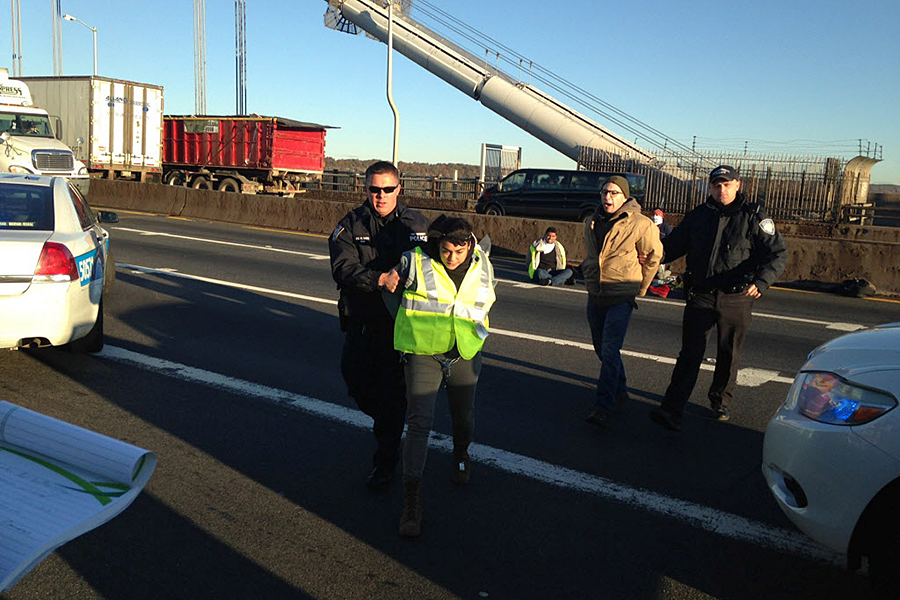An immigrant rights’ group blocks the GW Bridge: an effective way to protest?
Loading...
They normally work behind the counters of restaurants or behind the closed doors of laundry facilities. But on Wednesday morning, these workers were some of the 10 pro-immigrant protesters arrested after they chained themselves to each other on the George Washington Bridge, causing rush hour delays as long as 90 minutes into New York City, and unfurling a sign that read: "Resist, Organized, Act Up!"
"We are tired of being in the shadows," Mahoma López, who identifies as a spokesman for the protesters, and is co-director of Laundry Workers Center, told The Christian Science Monitor in a phone interview. "We need to be visible. We need to be a part of the decision process at the local level and at the national level."
The protesters associate with the hashtag, #somosvisibles, or #wearevisible. According to Mr. López, their goal is to raise awareness about the inequality immigrants face under American democracy. Laundry Workers Center – an organization that describes itself as providing leadership training for "improving the living and working conditions of workers in the laundry, warehouse, and food service industries" – said on its website that it helped organize the protest.
The blockade of dirt and paved roads and highways is a time-honored form of urban protest. From peasants to occupiers, this form of disruption has given a voice to those who have said they are voiceless. However, the motivations driving them to stop traffic have shifted from uprisings over food and other material needs to statements about recognition and rights, such as the Occupy and Black Lives Matter movements.
But if Wednesday's protesters lack concrete goals, or are not able to create or become part of a larger movement, they risk being remembered just for aggravating drivers, say experts on nonviolent and disruptive protests.
"What this kind of action tries to do is bring awareness to problems that may be ignored by the general public," says Jamila Raqib, the executive director of the Albert Einstein Institution, a Boston-based nonprofit that studies and advances the use of nonviolent actions. "It can be very effective for flexing political power by a small group to make their grievances known."
"But it needs to be done strategically," she says in a phone interview. "The question, in this case, is what are their objectives? Do they have specific demands? Or is it to raise awareness?"
According to López, a Mexican immigrant who lives in Queens, the protesters want to express that they feel left out of American democracy. The protesters also held up a sign that read, "Deport ICE," an acronym for US Immigration and Customs Enforcement. According to López, some of the protesters were from Mexico or the Caribbean, while others are pro-immigration supporters.
They stopped traffic on eastbound lanes of the bridge at about 8:15 a.m., said Port Authority spokesman Steve Coleman. They were removed by police by 8:30 a.m., and 10 of the protesters were arrested.
No one was injured Wednesday, although writers have previously pointed out the dangers of protesters' decisions to venture onto highways.
Demonstrators associated with #somosvisibles held a rally that night in Union Square in New York City. They also posted on Facebook the names of the 10 protesters they said were arrested on the bridge, calling for their release.
According to López, the protesters' actions come out of frustration at President Obama and presidential nominees Hillary Clinton and Donald Trump. Under Mr. Obama, more than 2 million immigrants have been deported, more than any previous administration. Mr. Lopez also cited Mr. Trump's disparaging remarks against Mexicans and other immigrants.
The tactic the protesters employed can be traced back to the 14th century, Joshua Clover, a professor at the University of California, Davis, and the author of "Riot. Strike. Riot: The New Era of Uprisings," told the San Francisco Chronicle in January.
"People blocked a county road, brought business to a halt, and said: 'This way of doing business isn't keeping us alive, it's killing us, and we're here to stop it," he said.
"It's significant that it has returned with a vengeance in the last few years," he says in an email to the Monitor. "In Britain in the 17th and 18th centuries, a real high-water mark for riots, the road blockade, was the single most common form, usually to prevent the export of grain by merchants in times of famine."
Now, he writes, the blockades of the Occupy and Black Lives Matter movements are less economic and more political.
"It often seems precisely to be a form of protest about rights and recognition before it is about seizing the basics of survival," he continues. "At the same time, it steps up the intensity of street protests by actively threatening to bring to a halt the whole organization of the world that violently excludes billions globally, millions locally, on a daily business."
The frustration of drivers could be seen in videos posted on social media Wednesday, in which angry drivers screamed at the protesters to get off the bridge, according to CBS affiliate New York.
"Get the hell out of here, you want to go protest, protest on your own time," one man was heard saying.
The success of the protest hinges on the actions of the protesters moving forward, say Clover and Ms. Raqib of the Albert Einstein Institution. These disruptive, nonviolent forms of protests, in and of themselves, can be effective. Raqib mentions Tiananmen Square and a 2013 demonstration in Kenya, where protesters brought a drove of pigs to Parliament with "MPigs" inscribed on them, a play on Members of Parliament (MP).
But if these protests lack grass-roots leadership, clear, concise goals, and a strategic plan to achieve these goals, observers caution, they, too, risk being remembered mostly for eye-catching tactics.
This report contains material from Reuters.







